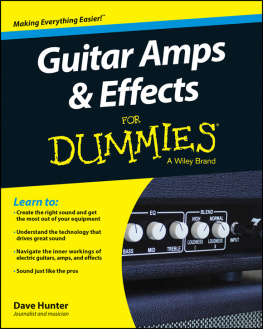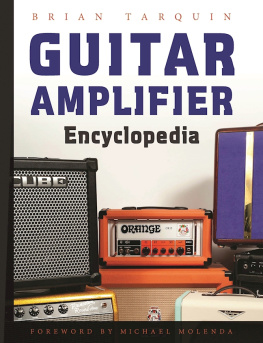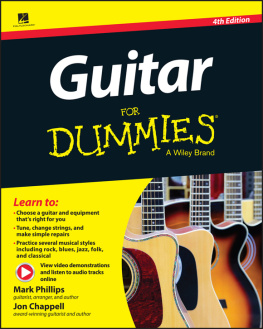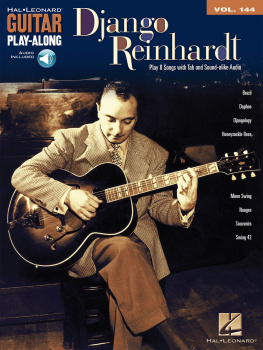

First published in 2013 by Voyageur Press, an imprint of MBI Publishing Company, 400 First Avenue North, Suite 400, Minneapolis, MN 55401 USA
2013 Voyageur Press
All rights reserved. With the exception of quoting brief passages for the purposes of review, no part of this publication may be reproduced without prior written permission from the Publisher.
The information in this book is true and complete to the best of our knowledge. All recommendations are made without any guarantee on the part of the author or Publisher, who also disclaims any liability incurred in connection with the use of this data or specific details.
We recognize, further, that some words, model names, and designations mentioned herein are the property of the trademark holder. We use them for identification purposes only. This publication has not been prepared, approved, or licensed by any of the manufacturers whose products are featured inside. This is not an official publication.
FENDER, GRETSCH, GUILD, JACKSON, CHARVEL, and the distinctive headstock designs commonly found on those guitars are trademarks of Fender Musical Instruments Corporation, and/or licensed to FMIC, and used herein with express written permission. All rights reserved. Neither FMIC nor Gretsch are affiliated in any way with author or publisher.
Voyageur Press titles are also available at discounts in bulk quantity for industrial or sales-promotional use. For details write to Special Sales Manager at MBI Publishing Company, 400 First Avenue North, Suite 400, Minneapolis, MN 55401 USA.
To find out more about our books, visit us online at www.voyageurpress.com.
Library of Congress Cataloging-in-Publication Data
Digital Edition: 978-1-61058-794-5
Softcover Edition: 978-0-76034-366-1
Hunter, Dave, 1962
365 guitars, amps & effects you must play : the most sublime, bizarre and outrageous gear ever / Dave Hunter.
pages cm
ISBN 978-0-7603-4366-1 (softcover)
1. GuitarMiscellanea. 2. Guitar amplifiersMiscellanea. 3. Effects pedalsMiscellanea.
I. Title. II. Title: Three hundred sixty-five guitars, amps and effects you must play.
ML1015.G9H856 2013
787.87192dc23
2012040561
Front cover photo: Fender Musical Instruments Corporation
photos: Michael Dregni
Editors: Dennis Pernu and Michael Dregni
Design managers: James Kegley and Cindy Laun
Design: Simon Larkin and Chris Fayers
Layout: Chris Fayers
Cover design: Simon Larkin
1866 Torres Classical
The most hallowed name in the history of classical guitar, Antonio de Torres consolidated the best work of luthiers of the mid-nineteenth century to bring the guitar forward to the twentieth century and beyond. As such, Torres is widely recognized as the father of the modern classical instrument and, essentially, the Stradivarius of the guitar. The thinner and more responsive soundboard, livelier and more structurally sound strutting, and simultaneously more ergonomic and tone-enhancing design of the best contemporary classical guitars can all be credited, to some degree, to Torres work. Unsurprisingly, Torres guitars are extremely rare and highly prized today, so getting your grubby hands on one is extremely unlikely. Nevertheless, any professional classical guitarist playing a top-shelf classical instrument will have had daily contact with Torres legacy in the guitars of later makers, such as Ramrez, Romanillos, Hauser, Hernndez, Fleta, Simplicio, and others who owe a great debt to the master. Should you get your fingers around a genuine Torres, however, note how the understated, even rather plain appearance gives way to a sublime voice mellowed and enhanced by the sonic patina that only 150 years of beautiful music can provide.

Courtesy Retrofret Vintage Guitars/www.retrofret.com/photo by George Aslaender
1910 Bohmann Harp Guitar
Freak of nature? Medieval torture device? Au contraire, its the Bohmann Harp Guitar, and as finger-twistingly unplayable as it might appear, this beast can produce sublime, almost otherworldly music in the right hands. Relatively few acoustic aficionados today are likely to have heard of Chicago guitar maker Joseph Bohmann, who immigrated to the United States in 1878 from Neumarkt, Bohemia (in present-day Germany). Bohmann was considered one of the most skilled luthiers working in the late nineteenth and early twentieth centuries, winning eight major international instrument-making prizes between 1888 and 1904. Once you realize that the bass strings on this guitars upper neck arent intended to be fretted but are harp strings plucked to resonate with the chord or melody being played on the lower neck, this monster becomes somewhat more approachable. Even so, this odd instrument that looks even more archaic than its century-old lineage would suggest is a work of art in wood and wire even before you approach it as a musical instrument.

Courtesy Outline Press Limited
1920s Dyer Symphony Harp Guitar Style 8
Like the Bohmann harp guitar, this elaborate instrument was designed as a somewhat conventional acoustic guitar with its own bass accompaniment. The enthusiasm with which many makers addressed the form in the early part of the twentieth century might have led guitarists to think that these were the real next step forward, and of all the various designs on the table at the time, the harp guitars sold by the Dyer company were possibly the most advanced. Rather than supporting the several heavy-gauge bass strings under tension with just a sturdy upper neck, a Dyer like this elaborately decorated Symphony Harp Guitar Style 8 had an entire body extension through which those drone strings would resonate, producing a haunting, ethereal sound. Dyer, based in St. Paul, Minnesota, didnt actually manufacture these harp guitars. Early examples were designed by Chris J. Knutsen, a Norwegian guitar maker working in the northeastern United States, and most were manufactured by the Larson Brothers of Chicago. Dyer harp guitars are exceedingly rare today; the instruments most acclaimed proponents include Stephen Bennett and Michael Hedges, who died in a car accident in 1997.

Courtesy Outline Press Limited
1920s Washburn Style A
Every player needs to have one of these little parlor guitars lying around, right? Preferably in that remote mountain cabin where you noodle endlessly in front of a crackling fire to renew your inspiration. (You do have a remote mountain cabin, too, right?) From the 1880s, Washburn guitars were manufactured by Chicagos Lyon & Healy of Chicago in styles clearly much inspired by Martin. Many were perfectly good little instruments right from the start, but by the postWorld War I period the company more consistently used X-bracing for their guitar tops, broadly improving their tone as a result. Aside from the great North American spruce and Brazilian rosewood that many of these petite beauties employed and the deluxe mother-of-pearl inlays that the top models carried, theres just something magical about coaxing a sweet, mellow tune out of such a tiny, old flat-top guitar. And while few such parlor-size Washburns offer much by way of volume, their tone can often be sublime.

















